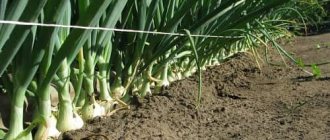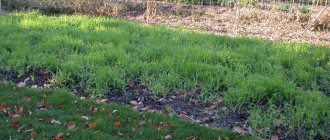Farmers cannot come to a common opinion: which garlic is better - spring or winter? The main thing in this matter is the purpose of planting: for example, spring crops are better stored and, if the conditions are met, can last until the next season.
Benefits of spring garlic
Spring garlic gives an excellent harvest, and fresh vitamin heads are useful to have during the long winter.
Read more about spring planting here.
Benefits of winter garlic
- when planted in autumn, the plant gets the opportunity to quickly adapt;
- better development in spring;
- high yield.
Today we will tell you about the features of planting garlic in the fall before winter.
Planting dates depend on the weather and temperature conditions, so they may vary in different climatic zones.
When to plant garlic in the fall
Winter garlic is planted from approximately the second ten days of September to the end of October. During this period, the earth already cools down sufficiently at night, but still has time to warm up on sunny days. This is excellent so that the cloves do not have time to germinate, but still have time to produce roots.
Dates for planting garlic in the fall depending on the region:
| Region | When to plant |
| Siberia, Urals and other northern regions | can plant garlic as early as September |
| Middle lane | may not rush until October |
| Southern regions | They can start planting vegetables in November and, in favorable weather, even in December. |
Lunar calendar 2022
It is known that lunar phases can have beneficial and unfavorable effects on plants. And young seedlings, seeds or bulbs, as well as fruits during the period of ripening and collection of juice, especially depend on them.
The following are considered favorable days to plant garlic in the fall of 2022:
- September: 5-7, 23-25, 28-30
- October: 2-4, 8-12, 15-18, 20-22, 27-31
- November: 3, 4, 12-14, 21, 23
- December: 2-4
Unfavorable days:
- September: 9-10, 26, 27
- October: 9, 10, 25, 26
- November: 1, 2, 7-9, 24, 25, 28, 29
- December: 7-9, 23-25
New and full moon days are considered the worst for planting winter garlic. It's better to wait them out.
In 2022, unfavorable days fall on the following dates:
- January – 2, 3, 17, 18
- February – 1, 2, 16, 28
- March – 1, 2, 18, 27, 28
- April – 1, 2, 16, 23
- May – 1, 16, 30
- June -14, 18, 29
- July – 13, 14, 28, 29
- August – 11, 12, 27-28
- September: 9-10, 26, 27
- October: 9, 10, 25, 26
- November: 1, 2, 7-9, 24, 25, 28, 29
- December: 7-9, 23-25
Choose the desired variety
Types of winter garlic differ among themselves in the size of the head, the number of cloves, keeping quality, taste and even aroma. You can choose a variety with good keeping quality, the desired bulb size or number of cloves.
| Name | Characteristic | Photo |
| Alcor mid-season | With a sharp taste and high yield. Qualities: frost resistance, dense head, up to 5 cloves, no more than 35 g. Stores well. | |
| Belarusian early ripening | Large (50−80 g), sharp, with good winter hardiness and keeping quality. Resistant to diseases. Up to 8 teeth. | |
| Gribovsky anniversary mid-season | Frost-resistant variety with a flat-round bulb up to 40 g. Qualities: drought and disease resistance. There are up to 10 cloves in an onion. | |
| Lyubasha mid-season | A high-yielding variety with excellent winter hardiness and resistance to drought and fusarium. Large onion (up to 120 g). Well kept. | |
| Mid-season sail | The variety is considered medium-sized (30−50 g), high-yielding. Pests and diseases: stem nematode, downy mildew, bacterial rot. | |
| Moscow region mid-season | Excellent frost and disease resistance, medium head (60 g), stores well. | |
| Spas mid-season | A large variety (100 g), combining such qualities as winter hardiness, excellent shelf life, and disease resistance. |
Selecting cloves and preparing them for planting
Winter varieties of garlic are very convenient:
- they are relatively unpretentious;
- have good immunity;
- frost resistance.
Also, winter varieties have a more pronounced taste and smell due to the natural ripening time.
It is important to remember that any planting material must be of ideal quality:
- The cloves are carefully selected approximately 15 days before the intended planting date. They must have an intact shell, be hard and healthy, without mechanical damage.
- No stains or chips are acceptable and such pieces must be rejected. For planting, only the outermost cloves are also used - they are fully mature and capable of further growth.
- The selected material must be dry, then it will be able to produce roots under the artificial greenhouse effect. The cloves are placed in a plastic bag, wrapped in paper and left for 10 days at room temperature. In the darkness and warmth, growth points awaken and roots appear.
As a rule, cloves of the same size are used for planting garlic in the fall before winter. But opinions differ on this issue.
According to Candidate of Agricultural Sciences Oktyabrina Ganichkina, garlic can be calibrated, but still be fully used: all suitable garlic is suitable for planting. But it is advisable to plant them according to size, without mixing.
After examining the cloves that have taken root, you should make sure they are healthy and have no green arrows. Garlic is ready to plant.
Important! If there are suspicions of weather instability, possible heavy rainfall and a high risk of rotting of the planting material, it is recommended to prepare the garlic for planting in the fall - disinfect the cloves.
To do this, they are lowered for a couple of hours in:
- ash solution,
- a weak solution of potassium permanganate or phytosporin.
Types of planting material for growing winter garlic
Above we looked at how and when to plant garlic cloves in the fall, now we’ll talk about other planting options.
Bulbs
In addition to cloves, so-called bulbs are used for planting garlic in the fall before winter. This is the seed material that is formed in some varieties of winter garlic.
Nature took care of this: winter garlic does not produce many cloves and for maximum reproduction it has the opportunity to shoot out an arrow strewn with aerial bulbs, of which there can be up to a hundred pieces.
However, growing them to a full harvest will take two years. But it's worth it! The fact is that only with the help of bulbs can you preserve the varietal properties of garlic and prevent it from being crushed. It will not be possible to propagate it with cloves indefinitely. In the first year, single-toothed heads will ripen, and in the second year, full-fledged heads will ripen.
heads
Planting garlic heads in the fall before winter is considered an option for the lazy. At first glance, this seems exactly like this, but in fact, this is the method of far-sighted gardeners. The fact is that in a year the planted head will give the result of 5-7 excellent healthy heads, also larger than the mother one. In the meantime, they will grow and form, they will bring invaluable benefits to the site in the form of protection from pests.
It is customary to plant the heads randomly around the garden and near currant or strawberry bushes in order to scare away almost everything - caterpillars, aphids, codling moths, fleas and moths. It's all about the released phytoncides, which are destructive for these parasites.
The care is the same as for planting cloves, or he is completely satisfied with what he gets from caring for the main plantings in the beds. Just remember to loosen and weed. You can also plant garlic around the tree trunks of fruit trees.
At the end of summer, the garlic tops will begin to turn yellow and wither. This is a signal about the ripening of the heads. In clear, dry weather, the heads are dug up and thoroughly dried.
The tops turn yellow and disappear very quickly due to their juiciness, so if you miss the moment, then it will be difficult to find one-toothed ones later. Do not delay harvesting.
More information about when and how to properly remove garlic from the garden.
Garlic is tied in small sheaves and dried in a suspended state in the shade and in the fresh air.
Rockambole
Many people are familiar with giant garlic with a mild odor and a very pleasant taste. This is not actually garlic - it is an unusual onion from the lily family, it is also called Egyptian onion, which ripens in the form of garlic cloves, only of enormous size. It is harvested in the fourth year after planting. The size of one clove can reach 50 g and barely fit in the palm of your hand. Cultivation of rocambole is carried out on the basis of two types of onions - hair onion and grape onion.
Growing this unusual crop is very interesting.
- Its green above-ground part blooms beautifully and landscapers take advantage of this: in the summer, the flowerbed will be covered with unusual bright balls of violet-lilac tones.
- Powerful stems with leaves covered with a matte bluish coating look no less impressive, giving the plant a certain grandeur and nobility.
- In addition to its pleasant appearance, rocambole is a tasty and healthy vegetable for the winter table.
It has a delicate taste, fragrant and rich in vitamins, so necessary during the winter months. The only drawback of this garlic is its short storage time. But this can be solved with pickling and preservation. Rocambole is also dried and crushed, and then used as a vitamin spice. And fresh it is especially tasty if it is baked whole and served with meat.
Useful tips
Each gardener has his own tricks and secrets for growing large garlic. Here are some useful tips:
- Regularly update planting material. Every three years, the plantings are rejuvenated by growing one-toothed bulbils from airy bulbs in advance.
- Breaking out the frogs allows you to get larger heads.
- It is advisable to leave several arrows on the bushes in order to determine the period of ripening and harvesting of the heads. The arrows are also useful for collecting air bulbs for landing.
- Observe planting dates, and then carefully care for the crop.
- Try several varieties on your plot, grow new selections. Many new productive varieties of winter garlic have been developed, characterized by frost resistance, large fruit, and resistance to diseases and pest attacks.
- When selecting a variety, take into account the recommendations of breeders and agronomists, your own experience, as well as the climatic conditions of the region.
Not so, it turns out, it’s difficult to prepare and plant winter garlic before winter. It is important not to confuse it with spring varieties, carry out all agrotechnical work in a timely manner, and next year an excellent crop harvest will be ensured!
5/5 — (3 votes)
Preparing the soil for planting
Winter garlic places the following requirements on the soil:
- The soil for garlic should be loose to a depth of at least 30 cm, nutritious, in a well-ventilated area in the open air. Maximum sun and light on cloudy days. Mix the clay soil well with peat. If you mix manure compost into the soil for at least 5 years, you will no longer have to fertilize and feed the garlic this season.
- If compost is not available, humus will do, followed by the addition of superphosphate and potassium salt. Don't forget about groundwater, especially during the upcoming rainy and snowy season. If the water is too close, then a small layer of sand is added to the holes under the cloves for drainage.
The bed for planting garlic in the fall should be well covered with snow in winter. If frost sets in before snow falls, as often happens in the Moscow region and in the middle zone in general, then you should cover the garlic with roofing felt.
It is not recommended to use mulch for winter garlic - it tends to rot and this will disrupt both the temperature regime under the shelter and create an incorrect level of humidity. But if there is a risk of severe frosts, for example, in Siberia and the Urals, then you need to cover it with a layer of dry peat and remove it in the spring.
Crop rotation and crop rotation
Garlic is very sensitive to soil, and its composition directly depends on crop rotation. Accordingly, the same crop is not planted in the same area for two years in a row, because this depletes the soil. uh
Below are the rules for crop rotation to obtain a high-quality garlic harvest.
- Garlic is not planted after root crops. Root vegetables are very voracious and it is impossible to obtain large garlic after them. It is strictly not recommended to use soil for garlic after potatoes due to the occurrence of diseases in garlic, for example, nematodes.
- If, after root crops, cabbage, legumes or melons were alternated in the beds for two years, then the soil will be ideal for garlic.
- Garlic grows well in the soil after any green manure. But you should avoid planting immediately after oats or barley.
- If the area was fertilized with fresh manure and not compost, then it is better not to plant garlic this year and next. It will grow mostly as a green mass, but the heads will be watery and cannot be stored for a long time.
- Winter garlic is a direct competitor to any spices. Therefore, it should not be planted with herbs, especially perennial ones.
Popular questions and answers
There are a number of questions that novice summer residents ask all the time. Let's look at them too.
Can winter garlic be planted in spring?
In order for winter garlic to form heads, it is important that it survives a cold period. This does not happen when planting in spring. As a result, the bulbs form worse, take longer, are poorly stored in winter and cannot be used as planting material.
Can spring garlic be planted in the fall?
Can. However, such varieties are not adapted to severe frosts - when planted in autumn, the cloves take root worse and often freeze out in winter. It turns out that during winter planting you can waste time and seed material. So it's better not to take risks.
How do you know when garlic is ripe?
The main sign of maturity is yellowing of the tips of the leaves. If the weather is dry, you can keep it in the ground for another week. But if it rains, you need to dig it up immediately, otherwise it will quickly rot.
Sources
- Group of authors ed. Polyanskoy A.M. and Chulkova E.I. Advice for gardeners // Minsk, Urozhay, 1970 – 208 p.
- Romanov V.V., Ganichkina O.A., Akimov A.A., Uvarov E.V. In the garden and vegetable garden // Yaroslavl, Verkhne-Volzhskoe book publishing house, 1989 – 288 p.
- State catalog of pesticides and agrochemicals approved for use on the territory of the Russian Federation as of July 6, 2022 // Ministry of Agriculture of the Russian Federation https://mcx.gov.ru/ministry/departments/departament-rastenievodstva-mekhanizatsii-khimizatsii- i-zashchity-rasteniy/industry-information/info-gosudarstvennaya-usluga-po-gosudarstvennoy-registratsii-pestitsidov-i-agrokhimikatov/
Rules for planting garlic, options for planting garlic
Everything is very simple:
- prepare furrows at a distance of 10-15 cm from each other;
- make holes with a diameter of 2-3 cm, a depth of 3 cm at a distance of 10-15 cm from each other;
- place the cloves strictly vertically, without pressing them into the ground;
- sprinkle with earth and do not compact;
- All manipulations should be carried out in dry, good weather.
How to choose seedlings
Planting material should strive for ideal and be prepared flawlessly. When planting, garlic bulbs should be large and even, consisting of no more than 5-6 cloves, in order to reproduce the same vegetable, impeccable in all respects, in the future harvest.
You need to divide the onion into cloves before processing them for planting. Each clove should be meticulously inspected and defective ones - those with mechanical damage, damaged shells, traces of mold, rot and other defects - should not be used for sowing.
Planting care
Care consists of timely shelter, and in the spring, after the temperature has settled above zero, the roofing material is removed and seedlings are allowed to emerge.
After germination, fertilizers are applied: mullein or diluted bird droppings. Garlic responds very well to fertilization with rabbit manure. After this, feeding will not be needed until mid-summer, until the formation and ripening of the heads.
Throughout the season, in the active growth phase, garlic is watered and weeded abundantly.
Attention! The most important moment in caring for garlic in the summer is not to miss the moment of removing the shoot, when it grows by about 10 cm. It is removed manually, and this gives the head the opportunity to develop. If this is not done, then all the nutrients will go into the growth of the arrow and the green above-ground part.
Mr. Summer Resident advises: an alternative planting method
Along with the usual method, there is another one - the lazy one. It is good in the following situations:
- the need to save space and time;
- single plantings to protect strawberries, shrubs, trees and other crops.
Step-by-step instruction
- Varieties with no more than five segments in the head are taken. The selection must be careful, the bulbs are hard, without traces of rot and disease.
- The upper scales are removed, the bottom is cut off from the roots, the stem is left approximately 5 cm high.
- The prepared material is soaked for a quarter of an hour in a weak saline solution (half a tablespoon of salt per liter of water).
- The planting depth is at least 10 cm, between the heads - about 30 cm.
- More plentiful food is required than during normal planting. Fertilizer is added directly to the holes. Humus mixed with garden diamite (teaspoon).
- The head is placed at the bottom and pressed down slightly. If the soil is infertile, compost is placed on top.
Video: all the intricacies of autumn planting garlic from the channel Garden, do-it-yourself vegetable garden
This is how the healing ancient garlic has been going with a person for many years and faithfully serves not only his health, but also his gourmet taste. From time immemorial, garlic has been an integral element of various spheres of human activity - from cooking to the army and traditional medicine; it is a Russian antibiotic, a savior in epidemics. We talked about planting garlic in the fall before winter. We hope the information will be useful to you.
Victor Immel My entire childhood was spent in nature, which probably predetermined my subsequent choice of profession - to become an agronomist. ...
What kind of soil is needed?
Ideal soil for garlic:
- loose (well permeable to air and moisture);
- with neutral acidity;
- quite fertile.
Based on this, it can be argued that garlic feels good in black soil or loamy soils. If the soil is heavy, then it is better to add river sand and peat to the holes. Garlic will also grow in sandy soil, but you will have to water and feed it more often.
But it is better not to use soils that are too acidic or alkaline for planting garlic.
Garlic needs loose, fertile soil.











